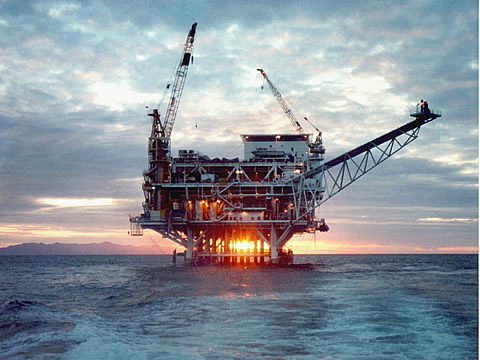
As world oil prices continue to slump, oil company executives everywhere are taking stock. So are politicians, environmental activists and ordinary people, wondering at the gas pump, or looking at their utility bills. And even despite all of this, Mexico continues to auction access to its oil fields, and the USA is pumping nearly 17% of its domestic oil from the same Gulf of Mexico.
Some of the oil that we burn in our cars, or that gets burnt to power our homes or that gets sold on the world market comes from deep beneath the sea. Extracting that oil and the natural gas that usually comes with it – is exceedingly expensive. It’s also incredibly dangerous and difficult to get to. So why bother?

Let’s look at everything that can go wrong.
Offshore oil rigs are almost like space ships. They’re unique and need to be strenuously outfitted for their environments, and for just one job. They’re also technologically incredibly complicated and complex, expensive and they’re cast off into the middle of the sea with but one purpose. Workers can be hurt, or even killed. Oil can be spilled polluting enormous stretches of ocean and wildlife habitat. Likewise, those same spills are sometimes accompanied by tremendous fires, that pollute the atmosphere, and that can burn for days simply because they’re occurring in places difficult to reach and where there’s only more ocean to try to put them out.
Part of the issue is, of course, tapping into a giant balloon of explosive gas that has lain hidden beneath the seafloor for millions of years. Pressure can be enormous and the movement of such gas can be unpredictable, deadly and fast. There’s not a lot that can account for all of the possible variables and all of the things that can go wrong.
The sheer cost of setting up a rig and drilling is already staggering. Tens of millions of dollars is hardly out of the question. All of that gets lost when the rig goes up in flames. And with increasingly heavy fines, even much more can be lost when the worst really comes to pass.
All of that expensive equipment is increasingly complex too. It can, and does, fail, at least from time to time. Every time, it needs to be professionally attended to, quickly, because as we know, offshore oil rigs operate continually on a precipice, and very near to disaster. Extremes of weather, waves, salt water and storms of ice and snow can also present exceptional challenges.
Frankly, very few companies have sufficient experience to safely drill at deep-water depths. And when you consider the tremendous risk to other areas of economic activity, including especially fishing and tourism, the risk of one more oil rig explosion and spill are quite alarming indeed. The costs of the Deepwater Horizon, in terms of environmental and economic impact and with regard to policies changes thereafter, are for all intents and purposes, incalculable. They run into the tens of billions of dollars.
So What Makes It Worth the Risk?
There are as much as 37 trillion cubic feet of gas and likely 4 billion barrels of oil off of the United States Atlantic Coast. Some of it is beneath treacherous water and in places where only the biggest and toughest rigs could possibly venture. The current administration put the permitting process on hold after the Deepwater Horizon disaster in 2010. The US Department of the Interior then announced that no leases on these oil and gas fields would be issued through 2017. But in the Gulf, and in many other deep sea locations around the Earth drilling continues and new rigs go into service.
However, oil and gas drilling continues in the Gulf of Mexico by US energy companies, and in Mexican waters, leases to exploit additional oil and gas fields are being sold by the State energy monopoly to additional international companies.
The amount of remaining petroleum resources in the Gulf of Mexico is limited, but still a rather staggering amount. Even more staggering, more than 70% of oil wells operating in the Gulf are drilled beneath 1,000 feet of water. The potential risk is enormous, but for these companies, the payoff is enormous too.
And that payoff continues to increase, even despite slumping prices and dwindling supplies. At their soonest, world oil prices are not likely to recover much in the next two years. Some analysts even believe that they may go lower. But oil exploration continues and new wells are being drilled. Interest in Mexico’s oil fields has only grown and some winning bidders have offered the Mexican government nearly 80% of their proceeds back in exchange for the right to tap these new deepwater oil fields. If 20% of an oil field is enough, then that should give you an idea of the amount of money they’re looking at making.







